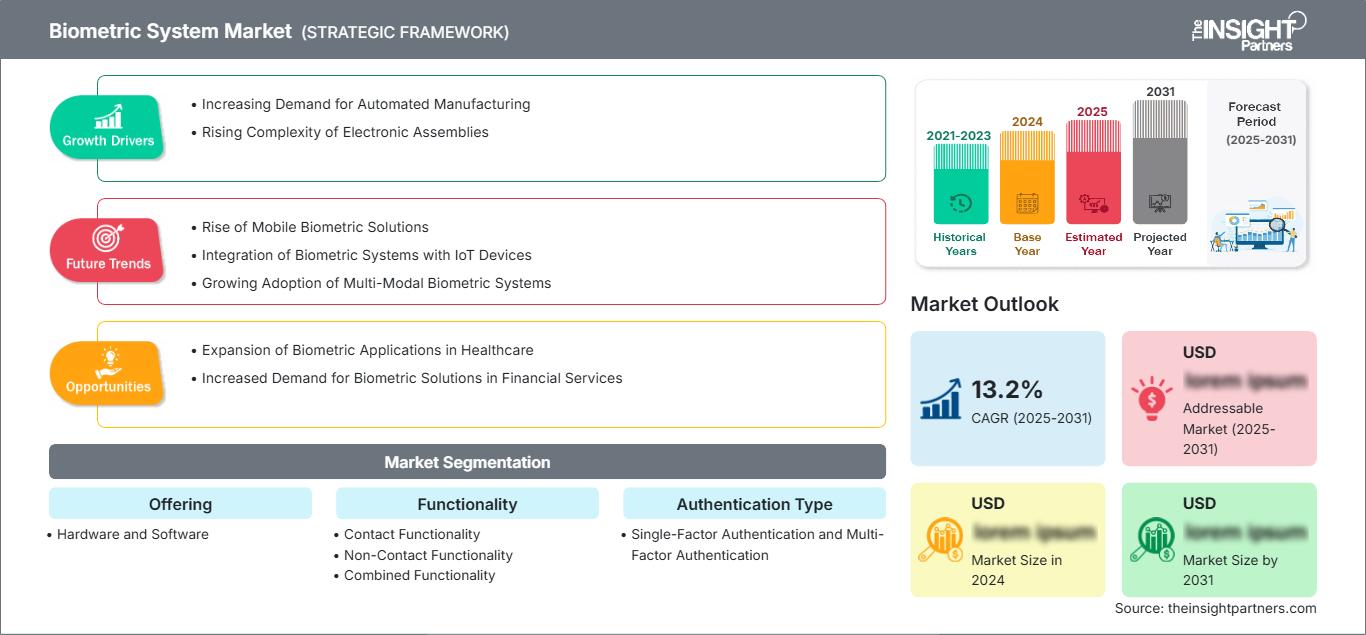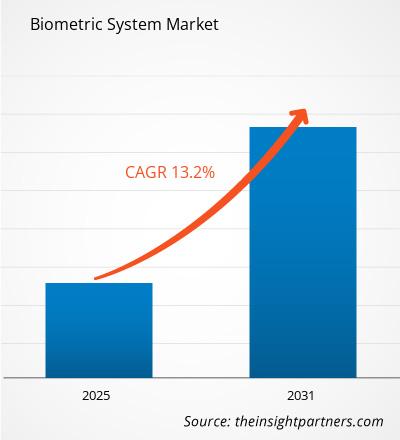Se espera que el mercado de sistemas biométricos registre una CAGR del 13,2 % entre 2025 y 2031, y que el tamaño del mercado se expanda de US$ XX millones en 2024 a US$ XX millones en 2031.
El informe está segmentado por oferta (hardware y software), funcionalidad (con contacto, sin contacto y combinada), tipo de autenticación (de factor único y multifactor) y usuario final (BFSI, gobierno, ejército y defensa, electrónica de consumo, salud, automoción y otros). El análisis global se desglosa por regiones y países principales. El informe ofrece el valor en USD para el análisis y los segmentos mencionados.
Propósito del Informe
El informe "Mercado de Sistemas Biométricos" de The Insight Partners busca describir el panorama actual y el crecimiento futuro, los principales factores impulsores, los desafíos y las oportunidades. Esto proporcionará información a diversas partes interesadas del negocio, como:
- Proveedores/fabricantes de tecnología: Para comprender la dinámica cambiante del mercado y conocer las oportunidades potenciales de crecimiento, lo que les permitirá tomar decisiones estratégicas informadas.
- Inversores: Realizar un análisis exhaustivo de tendencias respecto a la tasa de crecimiento del mercado, las proyecciones financieras del mercado y las oportunidades que existen en toda la cadena de valor.
- Órganos reguladores: Regular las políticas y las actividades policiales en el mercado con el objetivo de minimizar el abuso, preservar la confianza de los inversores y defender la integridad y estabilidad del mercado.
Segmentación del mercado de sistemas biométricos
Ofrenda
- Hardware y software
Funcionalidad
- Funcionalidad de contacto
- Funcionalidad sin contacto
- Funcionalidad combinada
Tipo de autenticación
- Autenticación de un solo factor y autenticación multifactor
Usuario final
- BFSI
- Gobierno
- Militar y defensa
- Electrónica de consumo
- Cuidado de la salud
- Automotor
Obtendrá personalización en cualquier informe, sin cargo, incluidas partes de este informe o análisis a nivel de país, paquete de datos de Excel, así como también grandes ofertas y descuentos para empresas emergentes y universidades.
Mercado de sistemas biométricos: perspectivas estratégicas

- Obtenga las principales tendencias clave del mercado de este informe.Esta muestra GRATUITA incluirá análisis de datos, desde tendencias del mercado hasta estimaciones y pronósticos.
Factores que impulsan el crecimiento del mercado de sistemas biométricos
- Creciente demanda de fabricación automatizada: La transición hacia la automatización en los procesos de fabricación es un factor clave para el mercado de las máquinas de inserción de pasadores. Estas máquinas optimizan el proceso de ensamblaje, mejorando la velocidad y la precisión de la producción, y reduciendo los costos de mano de obra. Industrias como la electrónica, la automoción y la fabricación industrial requieren una colocación de componentes eficiente y precisa, lo que hace que las máquinas de inserción de pasadores automatizadas sean cruciales para mejorar la productividad general y la consistencia en las líneas de ensamblaje.
- Creciente complejidad de los ensamblajes electrónicos: A medida que los componentes electrónicos se vuelven más compactos y complejos, crece la necesidad de soluciones de ensamblaje precisas, como las máquinas de inserción de pines. Los dispositivos electrónicos modernos requieren conexiones de componentes fiables y precisas, y las máquinas de inserción de pines son esenciales para satisfacer estas demandas. La creciente complejidad de las placas de circuitos electrónicos y los conectores en diversos sectores está impulsando la adopción de la tecnología de inserción de pines.
Tendencias futuras del mercado de sistemas biométricos
- Auge de las soluciones biométricas móviles: La tendencia hacia las soluciones biométricas móviles cobra impulso a medida que los teléfonos inteligentes y los dispositivos portátiles incorporan cada vez más funciones de autenticación biométrica. Los lectores de huellas dactilares, el reconocimiento facial y el reconocimiento de voz son ahora estándar en muchos dispositivos móviles, lo que facilita a los usuarios el acceso seguro a sus aplicaciones. Esta tendencia no solo mejora la comodidad del usuario, sino que también impulsa la adopción de sistemas biométricos en diversos sectores, como la banca, el comercio electrónico y la sanidad, donde el acceso móvil se está volviendo esencial.
- Integración de sistemas biométricos con dispositivos IoT: La integración de sistemas biométricos con el Internet de las Cosas (IoT) se está convirtiendo en una tendencia importante. A medida que más dispositivos se interconectan, crece la necesidad de métodos de autenticación seguros. Los sistemas biométricos pueden mejorar la seguridad de los dispositivos IoT al proporcionar autenticación de usuarios para sistemas domésticos inteligentes, aplicaciones industriales y vehículos conectados. Se espera que esta integración impulse la demanda de soluciones biométricas, ya que los usuarios buscan garantizar la seguridad de sus entornos interconectados frente al acceso no autorizado.
- Creciente adopción de sistemas biométricos multimodales: Existe una notable tendencia hacia la adopción de sistemas biométricos multimodales, que combinan dos o más características biométricas para la autenticación. Al integrar diferentes métodos, como el escaneo de huellas dactilares con el reconocimiento facial, estos sistemas proporcionan mayor precisión y seguridad. Esta tendencia es especialmente importante en entornos de alta seguridad, donde un solo método puede no ser suficiente. El creciente reconocimiento de las ventajas de los sistemas multimodales está impulsando a las organizaciones a invertir en soluciones biométricas más sofisticadas.
Oportunidades de mercado de sistemas biométricos
- Expansión de las aplicaciones biométricas en la atención médica: El sector sanitario ofrece importantes oportunidades para los sistemas biométricos, especialmente en la identificación de pacientes y el control de acceso. La autenticación biométrica puede agilizar los procesos de registro de pacientes, reducir el riesgo de robo de identidad médica y garantizar el acceso seguro a los historiales médicos. A medida que los centros sanitarios buscan mejorar la seguridad de los pacientes y la eficiencia operativa, se prevé un aumento en la implementación de sistemas biométricos para el acceso seguro y la verificación de identidad, lo que generará una lucrativa oportunidad de mercado.
- Aumento de la demanda de soluciones biométricas en los servicios financieros: El sector financiero reconoce cada vez más la necesidad de medidas de seguridad avanzadas para proteger la información confidencial de los clientes y prevenir el fraude. Los métodos de autenticación biométrica, como el reconocimiento de voz y el escaneo de huellas dactilares, se están integrando en las aplicaciones bancarias y los sistemas de pago para mejorar la seguridad y la experiencia del cliente. Esta creciente demanda de soluciones biométricas en las transacciones financieras representa una valiosa oportunidad para que los proveedores de tecnología desarrollen soluciones innovadoras adaptadas a las necesidades de este sector.
Perspectivas regionales del mercado de sistemas biométricos
Los analistas de The Insight Partners han explicado detalladamente las tendencias y los factores regionales que influyen en el mercado de sistemas biométricos durante el período de pronóstico. Esta sección también analiza los segmentos y la geografía del mercado de sistemas biométricos en Norteamérica, Europa, Asia Pacífico, Oriente Medio y África, y Sudamérica y Centroamérica.
Alcance del informe de mercado de sistemas biométricos
| Atributo del informe | Detalles |
|---|---|
| Tamaño del mercado en 2024 | US$ XX millones |
| Tamaño del mercado en 2031 | US$ XX millones |
| CAGR global (2025-2031) | 13,2% |
| Datos históricos | 2021-2023 |
| Período de pronóstico | 2025-2031 |
| Segmentos cubiertos | Ofreciendo
|
| Regiones y países cubiertos | América del norte
|
| Líderes del mercado y perfiles de empresas clave |
|
Densidad de actores del mercado de sistemas biométricos: comprensión de su impacto en la dinámica empresarial
El mercado de sistemas biométricos está creciendo rápidamente, impulsado por la creciente demanda de los usuarios finales debido a factores como la evolución de las preferencias de los consumidores, los avances tecnológicos y un mayor conocimiento de los beneficios del producto. A medida que aumenta la demanda, las empresas amplían su oferta, innovan para satisfacer las necesidades de los consumidores y aprovechan las tendencias emergentes, lo que impulsa aún más el crecimiento del mercado.

- Obtenga una descripción general de los principales actores clave del mercado de sistemas biométricos
Puntos clave de venta
- Cobertura integral: el informe cubre exhaustivamente el análisis de productos, servicios, tipos y usuarios finales del mercado de sistemas biométricos, proporcionando un panorama holístico.
- Análisis de expertos: el informe se compila con base en el conocimiento profundo de expertos y analistas de la industria.
- Información actualizada: El informe asegura relevancia comercial debido a su cobertura de información reciente y tendencias de datos.
- Opciones de personalización: este informe se puede personalizar para satisfacer los requisitos específicos del cliente y adaptarse adecuadamente a las estrategias comerciales.
Por lo tanto, el informe de investigación sobre el mercado de sistemas biométricos puede ayudar a descifrar y comprender el panorama de la industria y sus perspectivas de crecimiento. Si bien existen algunas preocupaciones válidas, las ventajas generales de este informe suelen superar las desventajas.
- Análisis histórico (2 años), año base, pronóstico (7 años) con CAGR
- Análisis PEST y FODA
- Tamaño del mercado, valor/volumen: global, regional y nacional
- Industria y panorama competitivo
- Conjunto de datos de Excel
Informes recientes
Informes relacionados
Testimonios
Razón para comprar
- Toma de decisiones informada
- Comprensión de la dinámica del mercado
- Análisis competitivo
- Información sobre clientes
- Pronósticos del mercado
- Mitigación de riesgos
- Planificación estratégica
- Justificación de la inversión
- Identificación de mercados emergentes
- Mejora de las estrategias de marketing
- Impulso de la eficiencia operativa
- Alineación con las tendencias regulatorias






















 Obtenga una muestra gratuita para - Mercado de sistemas biométricos
Obtenga una muestra gratuita para - Mercado de sistemas biométricos